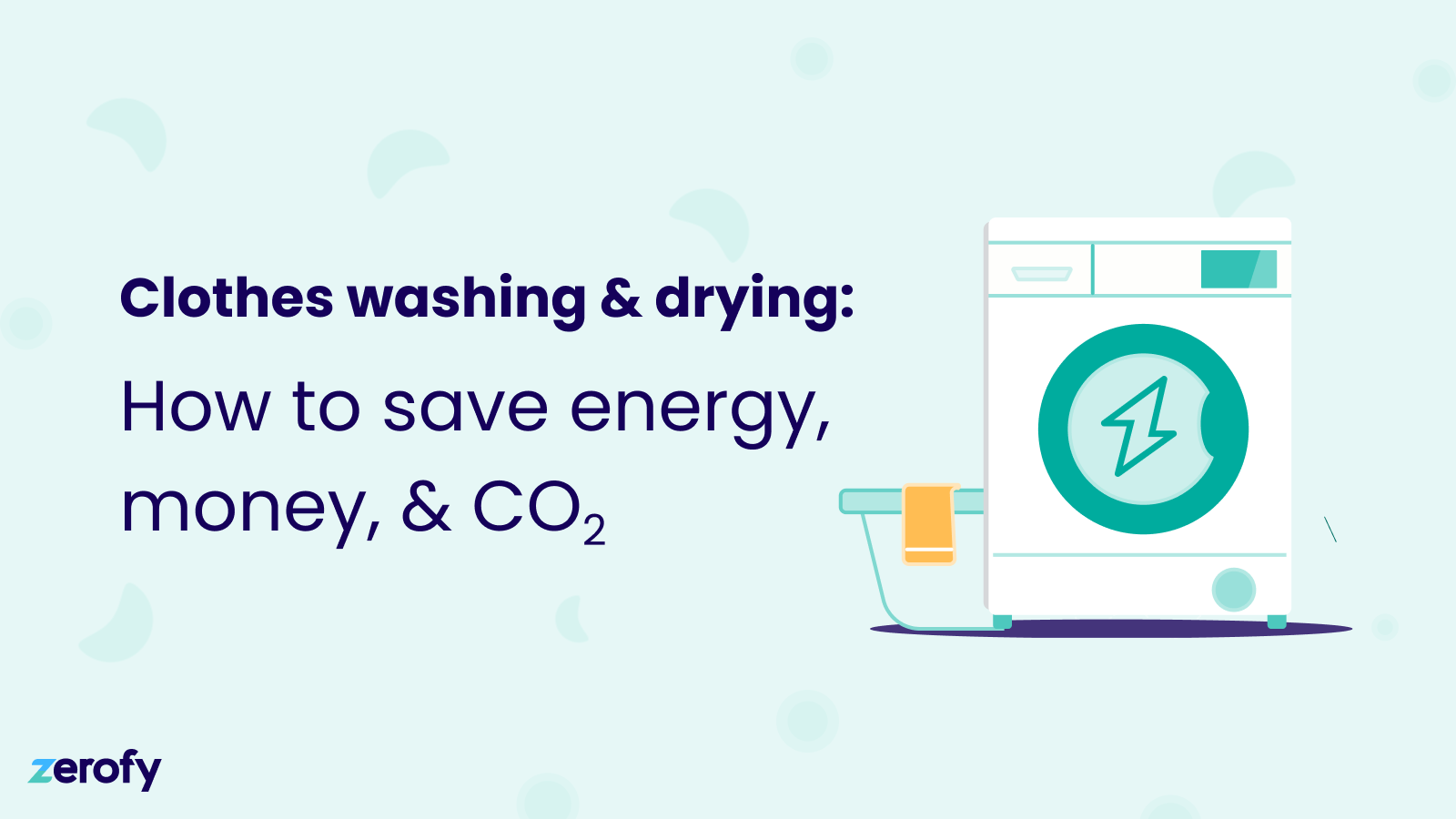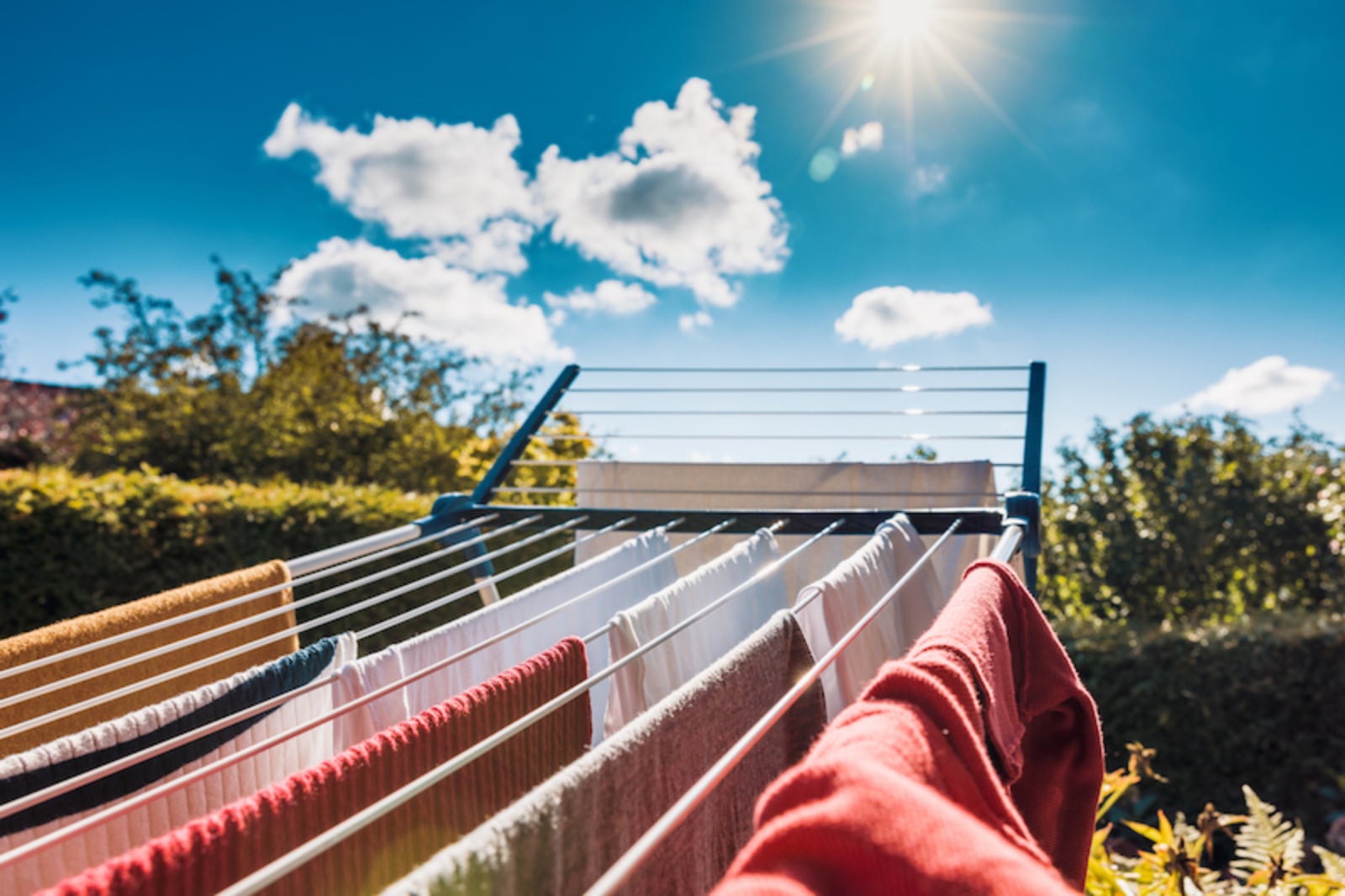How to save energy, CO2, and money on clothes washing and drying

Appliances used in your household are among those devices that use the most energy. Due to their energy consumption, using energy-efficient appliances and using them in the right ways can save your household noticeable amounts of energy, money, and of course, CO2 emissions.
Below we will be looking at how clothes washers and dryers impact household energy usage. These are two devices that get a lot of use in the home, and present many opportunities for savings. We will explore some painless ways that you can adjust your washing and drying routines, as well as how the Zerofy app can help.
The energy impact of washing and drying
Depending on household size, the number of loads washed per year varies. A 2004 study in Germany analyzed that an average number of loads washed per household per year is 164. For a one person household, the number is 111, and for a household with more than four people, the number of loads grows to 211.
The energy use of the top energy efficient washers versus low-end devices can vary by more than a factor of 2-2.5 (source Source: Energy Star and topten.ch) even for new devices. Here it is important to mention that the top-loaders popular in the US 25% more energy and water than front load washers. Front load washers also spin clothes much more quickly than top load washers, which means households can save on drying time and energy by choosing them (Source: Energy Star).
For a family of four doing 211 cycles per year, the energy difference between the top and low end of a new model is 150 kWh versus 320 kWh per year. In other words, 170kWh of energy can be saved by using a top range model. Assuming 30 cent/kWh electricity tariff (Germany) over the lifetime (15 years) of the device about 700 Euro can be saved. With recent rates even almost 1000 Euro. The CO2 impact in Germany (460 g/kWh) would be 1.1 tons (!) of CO2 saved (assuming constant electricity)
The situation is even more significant for dryers, especially when comparing modern devices to older ones: a new dryer saves 2kWh per cycle compared to an old one. With the same amount of cycles (211), a household can save 422 kWh of energy annually. Over the device lifetime, savings would be 1900 Euro in energy costs and almost 3 tons of CO2.
In combination, the use of modern energy-saving appliances for washing and drying can save more than 2500 Euro, and more than 4 tons of CO2.
Also note that buying a new device makes sense from an emissions perspective if you are using it frequently, because the emissions in use versus manufacturing are about 70% vs 30% (Source: Miele).
Washer and dryer innovations
Many modern washers and dryers are manufactured with efficient innovations that can contribute to lower energy use and emissions.
1. Eco cycles
Eco mode or cycle is a program on some washing machines that uses lower wash and rinse temperatures. This means there is less energy needed for heating, and less water used while still getting your clothes clean. Read below for more info on eco cycles.
2. Heat pump dryers
Traditional dryers typically have simply a heating element and a vent that releases the warm air generated by drying clothes to the outside of the home. A heat pump dryer uses a different process in that it sends the warm air through an evaporator. This removes moisture from the air, without losing a lot of heat. Heat pump dryers use at least 28% less energy than conventional dryers (Source: Energy Star). You can learn more about how heat pumps work here.
3. Recognising the amount of laundry
Some washing machines contain a sensor that is able to detect the size of the laundry load, and therefore how much water will be required. This is a benefit to your household because it is an automatic way that you can avoid wasting water and energy you don’t need, and reduce costs. (Source: [1,8]).
4. Detergent dosing
Washing machine dosing is a function in models where a sensor ensures the right amount of detergent is added to a wash load. This means your clothes will be cleaned effectively without using excess detergent. Using too much detergent can leave residue on clothes and damage the washing machine over time, so you are also contributing to a potential longer lifetime of your appliance by dosing. A 2008 study found that automatic dosing systems can save approximately 30% of detergent. (Source: Consumer Reports and [3]).
Actions you can take
1. Use your washing machine’s eco-cycle
A modern eco cycle can save 0.5kWh compared to a standard cycle [11]. Again assuming a family of four with 211 loads of laundry that 105kWh per year saved, or almost 50kg of CO2 emissions per year (example Germany)
You may have noticed the eco-cycle setting on washing machines, but perhaps aren’t sure how it works, or what the benefits are in terms of energy savings. The most energy intensive part of washing clothes is actually heating the hot water. For each laundry cycle, around 75% of the total energy used is in heating the hot water. While there is no standard eco-cycle setting across the board, devices with the setting typically adjust the temperature, water usage, and wash length. Eco-cycles will use colder water, requiring less energy to heat it. They also tend to use less water than a standard cycle, which means that the water can be heated more quickly.
You might find it confusing that the eco-cycle can actually last longer than a standard cycle, and wonder if this runs counter to saving energy. The reason this happens is because the longer cycle provides the washing machine sufficient time to properly clean your clothes, while using less water. The energy saved from heating less water compensates for the fact that the cycle is longer. Plus, heating up water requires more energy than turning the device’s drum. In addition to reducing your household carbon footprint with this action, you also may be able to save money on your utility bills by consistently washing your clothes using the eco-cycle.
2. Reduce your clothes dryer usage
Again, assuming our family of four with two children, and the 211 cycles, if using the dryer only for 20% of the loads instead of all the loads the family could save 170 kWh with a modern dryer and even 506kWh with an old dryer. This leads to annual emissions savings of about 80kg, or 230kg, respectively.
Choosing to air dry your clothes instead of tumble-drying can be a great way to reduce your emissions. This is especially true when your grid electricity is not green (which you can also find out in the Zerofy app). By hanging your clothes on the line outside, or on a rack inside, you can save money and reduce your household emissions. If you live in a small space with no yard or balcony, and are unsure you have the room to air dry your clothing, explore vertical drying racks or those that fold down from your wall.

We aren’t suggesting you completely stop using your clothes dryer. You can simply consider using it less. For example, when you have time to let your clothes dry, or the sun is out, you could air-dry. If you need certain clothes dried quickly, like if your kids have sports uniforms they need to wear in an hour, that might be a time it makes more sense to use the clothes dryer.
Bonus: If you have a Miele dryer, you can connect it to Zerofy to gain insights into your drying behaviors and track your progress towards making reductions.
Start taking action on washing & drying.
How the Zerofy app can help
1. Tracks energy and CO2 use
Zerofy tracks your households energy use and associated CO2 emissions in real-time. This can help you to identify how much energy you are using, and when, and take action to reduce. This can help you overall to understand the sources of your household’s carbon footprint, and make more informed decisions. If you own an Internet connected appliance (washer, dryer, dishwasher) from Miele (other brands will be added soon) we track all the uses and related energy use as well as emissions right in the app. It’s quick to set up: just connect your Miele@home cloud account in the Zerofy app.
2. Reports low intensity carbon and price times
The Zerofy app will show you the real-time carbon intensity of your electricity grid. Grid carbon intensity is not static: it changes day-by-day and hour-by-hour, depending on the composition of renewable and non-renewable energy. In the Zerofy app, you can view this information so that you know when the carbon intensity of your grid is low, and therefore the electricity is the most green. You can also see at the same time the price of the electricity.

This means you can make the best decisions energy and cost-wise about when to run your washing machine and clothes dryer. You can even opt-in to get notifications from the app when grid carbon intensity is low. You can think of this feature as a useful tool to help you reduce the emissions associated with an activity you were already going to do anyways.
3. Track washer dryer usage ratio for connected washers from Miele
As described above, if you connect your Miele devices, Zerofy tracks their usage and consumption. But not only that, Zerofy features an Action which helps you track automatically how often you use the dryer in relation to the number of washes (keeping in mind for example the 20% target from above). The video below shows this feature:
The app tracks the numbver of washer and dryer runs, the ratio of those, but also the total energy use for each month.
To start tracking and optimizing yor washer and dryer energy Download Zerofy now.
Sources and Assumptions
Assumptions for washer’s energy use from [1]:
Top class device from year 2000 for 7kg laundry: 60 degrees: 1.33 kWh / 30 degrees: 0.44 kWh.
Lower end device: 60 degrees: 2.73 kWh / 30 degrees: 1.0 kWh
Standard use washing programme:
We assume 70% at 30 degree and 30% at 60 degree.
Assumption for Germany’s CO2 intensity:
406g/kWh from electricitymaps.com
Assumption for electricity price in Germany:
0.3 EUR / kWh.
Sources: [1] https://www.oeko.de/oekodoc/257/2004-036-de.pdf
[3] https://www.oeko.de/oekodoc/757/2008-220-de.pdf
[4] https://www.energystar.gov/products/clothes_washers
[5] https://www.energystar.gov/products/appliances/clothes_washers/key_product_criteria
[6] https://www.energystar.gov/products/heat_pump_dryer
[7] https://www.forum-waschen.de/online-waschrechner.html
[8] https://www.bestech.com.au/industries/condition-monitoring/load-detection-washing-machines
[9] https://www.consumerreports.org/washing-machines/how-much-laundry-detergent-to-use/
[10] https://www.youtube.com/watch?v=xxPmDgjdQKQ
[12] https://www.energieverbraucher.de/de/tipp4-waschtemperatur__1978/
[13] https://www.energieverbraucher.de/de/tipp22-waschgewohnheiten__1969/